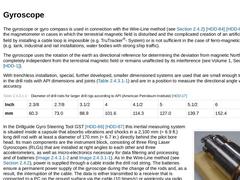
|
The gyroscope or gyro compass is used in connection with the Wire-Line method (see (Wire-Line method)) [HDD-84] [HDD-85]. It replaces the magnetometer in cases in which the terrestrial magnetic field is disturbed and the complicated creation of an artificial magnetic field by installing a cable loop is impossible (e.g. TruTracker®- System) or is not sufficient in the case of ferro-magnetic influence (e.g. tank, industrial and rail installations, … |
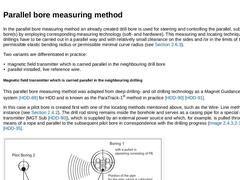
|
In the parallel bore measuring method an already created drill bore is used for steering and controlling the parallel, subsequent pilot bore(s) by employing corresponding measuring technology (soft- and hardware). This measuring and locating techniques is used if drillings have to be carried out in a parallel way and with relatively small clearance on the sides and /or in the limits of the minimally permissible elastic bending radius or permissible … |
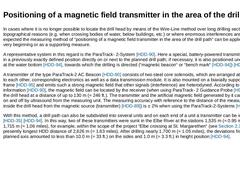
|
In cases where it is no longer possible to locate the drill head by means of the Wire-Line method over long drilling sections due to topographical reasons (e.g. when crossing bodies of water, below buildings, etc.) or where enormous interferences are to be expected the measuring method of “positioning of a magnetic field transmitter in the area of the drill path“ can be applied from the very beginning or as a supporting measure. A representative system … |
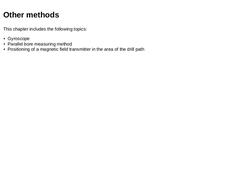
|
The following locating techniques, for example, belong to alternative locating techniques that are only employed in major drilling technology: -
gyroscope,
-
parallel bore measuring method,
-
positioning of a magnetic field sensor in the environment of the drill path.
DWA-A 125 [HDD-10] recommends to employ a gyroscope or gyro compass or the parallel bore measuring method in hardly accessible or non-accessible areas with strong magnetic interferences. |

|
HDD used in trenchless installation is counted among the near-surface directional drilling methods. While drilling, its spatial path is controlled and, if necessary, directionally oriented or influenced by means of technical or technological measures for the purpose of corresponding to the planned drilling profile [HDD-67] [HDD-68]. This influencing not only includes the maintenance of the prescribed drilling profile, but also the correction of natural … |

|
In carrying out drillings, difficulties in part are inherent to this type of work repeatedly occur and thus lead to enormous financial losses on the client’s as well as on the contractor’s side. These failed drillings also are frequently caused by insufficient construction preparations as well as insufficient geotechnical investigations or explorations by the client and the contractor. Such investigations are a critical part of the use of this method [… |
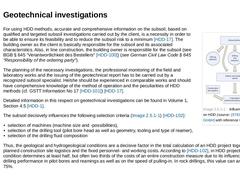
|
(Image: Influence of the subsoil on HDD)For using HDD methods, accurate and comprehensive information on the subsoil, based on qualified and targeted subsoil investigations carried out by the client, is a necessity in order to be able to ensure its feasibility and to reduce the subsoil risk to a minimum [HDD-17]. The building owner as the client is basically responsible for the subsoil and its associated characteristics. Also, in line construction, … |
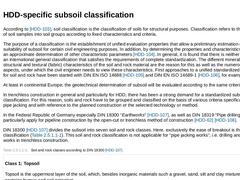
|
According to [HDD-103], soil classification is the classification of soils for structural purposes. Classification refers to the categorizing of soil samples into soil groups according to fixed characteristics and criteria. The purpose of a classification is the establishment of unified evaluation properties that allow a preliminary estimation of the suitability of subsoil for certain civil engineering purposes. In addition, by determining the properties … |
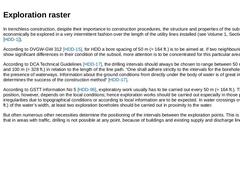
|
In trenchless construction, despite their importance to construction procedures, the structure and properties of the subsoil can only economically be explored in a very intermittent fashion over the length of the utility lines installed (see Volume 1, Section 4.5 [HDD-1]). According to DVGW-GW 312 [HDD-15], for HDD a bore spacing of 50 m (≈ 164 ft.) is to be aimed at. If two neighbouring drill profiles show significant differences in their condition … |
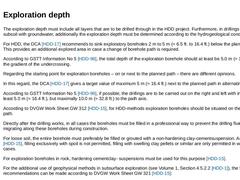
|
The exploration depth must include all layers that are to be drilled through in the HDD project. Furthermore, in drillings through subsoil with groundwater, additionally the exploration depth must be determined according to the hydrogeological conditions. For HDD, the DCA [HDD-17] recommends to sink exploratory boreholes 2 m to 5 m (≈ 6.5 ft. to 16.4 ft.) below the planned line axis. This provides an additional explored area in case a change of borehole … |
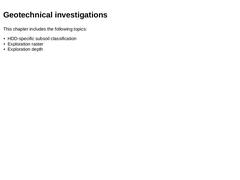
|
(Image: Influence of the subsoil on HDD)For using HDD methods, accurate and comprehensive information on the subsoil, based on qualified and targeted subsoil investigations carried out by the client, is a necessity in order to be able to ensure its feasibility and to reduce the subsoil risk to a minimum [HDD-17]. The building owner as the client is basically responsible for the subsoil and its associated characteristics. Also, in line construction, … |
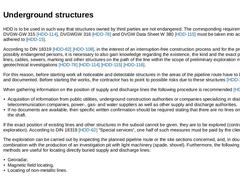
|
HDD is to be used in such way that structures owned by third parties are not endangered. The corresponding requirements by DVGW-GW 315 [HDD-114], DVGWGW 316 [HDD-78] and DVGW Data Sheet W 380 [HDD-115] must be taken into account and adhered to [HDD-15]. According to DIN 18319 [HDD-62] [HDD-108], in the interest of an interruption-free construction process and for the protection of possibly endangered persons, it is necessary to also gain knowledge … |
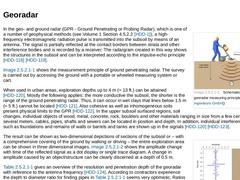
|
(Image: Schematic view of the georadar measuring principle)In the geo- and ground radar (GPR - Ground Penetrating or Probing Radar), which is one of a number of geophysical methods (see Volume 1 Section 4.5.2.2 [HDD-1]), a high-frequency electromagnetic radiation pulse is transmitted into the subsoil by means of an antenna. The signal is partially reflected at the contact borders between strata and other interference bodies and is recorded by a receiver. … |
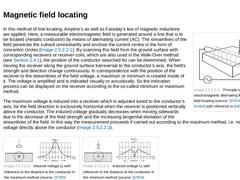
|
(Image: Principle of locating electromagnetic alternating fields – magnetic field locating)In this method of line locating, Ampère’s as well as Faraday’s law of magnetic inductions are applied. Here, a measurable electromagnetic field is generated around a line that is to be located (metallic conductor) by means of alternating current (AC). The streamlines of the field penetrate the subsoil unresistantly and enclose the current centre in the form … |
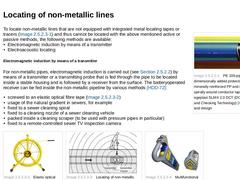
|
(Image: PE 100-pipe with dimensionally added protective coating of minerally reinforced PP and integrated, spirally wound conductor tape of the type egeplast SLM® 2.0 DCT (DCT – Detection and Checking Technology) – View and design)To locate non-metallic lines that are not equipped with integrated metal locating tapes or tracers (Figure 246a) and thus cannot be located with the above mentioned active or passive methods, the following methods are available: |
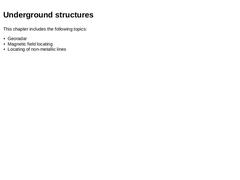
|
HDD is to be used in such way that structures owned by third parties are not endangered. The corresponding requirements by DVGW-GW 315 [HDD-114], DVGWGW 316 [HDD-78] and DVGW Data Sheet W 380 [HDD-115] must be taken into account and adhered to [HDD-15]. According to DIN 18319 [HDD-62] [HDD-108], in the interest of an interruption-free construction process and for the protection of possibly endangered persons, it is necessary to also gain knowledge … |

|
If supply or discharge lines are drilled into in spite of thorough preliminary exploration measures, various rules of conduct are to be observed by the drill operator and the personnel at the construction site depending on the line type concerned [HDD-65] [HDD-128]. |
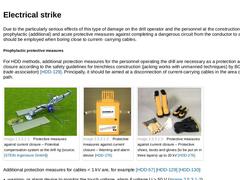
|
Due to the particularly serious effects of this type of damage on the drill operator and the personnel at the construction site, both prophylactic (additional) and acute protective measures against completing a dangerous circuit from the conductor to another object should be employed when boring close to current- carrying cables. Prophylactic protective measures For HDD methods, additional protection measures for the personnel operating the drill are … |
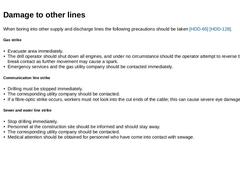
|
When boring into other supply and discharge lines the following precautions should be taken [HDD-65] [HDD-128]. Gas strike -
Evacuate area immediately.
-
The drill operator should shut down all engines, and under no circumstance should the operator attempt to reverse the bore to break contact as further movement may cause a spark.
-
Emergency services and the gas utility company should be contacted immediately.
Communication line strike |

|
If supply or discharge lines are drilled into in spite of thorough preliminary exploration measures, various rules of conduct are to be observed by the drill operator and the personnel at the construction site depending on the line type concerned [HDD-65] [HDD-128]. |

|
In carrying out drillings, difficulties in part are inherent to this type of work repeatedly occur and thus lead to enormous financial losses on the client’s as well as on the contractor’s side. These failed drillings also are frequently caused by insufficient construction preparations as well as insufficient geotechnical investigations or explorations by the client and the contractor. Such investigations are a critical part of the use of this method [… |
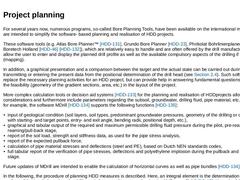
|
For several years now, numerous programs, so-called Bore Planning Tools, have been available on the international market. They are intended to simplify the software- based planning and realisation of HDD projects. These software tools (e.g. Atlas Bore Planner™ [HDD-131], Grundo Bore Planner [HDD-23], Phrikolat Bohrlinienplaner [HDD-54], Boretech Holland [HDD-46] [HDD-132]), which are relatively easy to handle and are often offered by the drill manufacturers, … |
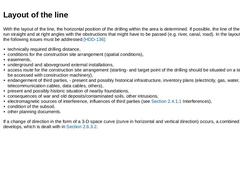
|
With the layout of the line, the horizontal position of the drilling within the area is determined. If possible, the line of the drilling should run straight and at right angles with the obstructions that might have to be passed (e.g. river, canal, road). In the layout of the line, the following issues must be addressed [HDD-136]: -
technically required drilling distance,
-
conditions for the construction site arrangement (spatial conditions),
-
easements,
|
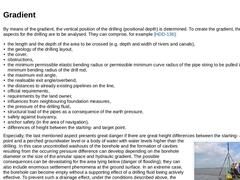
|
By means of the gradient, the vertical position of the drilling (positional depth) is determined. To create the gradient, the compulsory aspects for the drilling are to be analysed. They can comprise, for example [HDD-136]: -
the length and the depth of the area to be crossed (e.g. depth and width of rivers and canals),
-
the geology of the drilling layout,
-
the cover,
-
obstructions,
-
the minimum permissible elastic bending radius or permissible minimum …
|
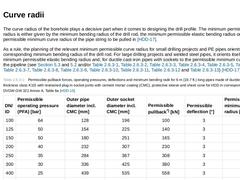
|
The curve radius of the borehole plays a decisive part when it comes to designing the drill profile. The minimum permissible curve radius is either given by the minimum bending radius of the drill rod, the minimum permissible elastic bending radius or the permissible minimum curve radius of the pipe string to be pulled in [HDD-17]. As a rule, the planning of the relevant minimum permissible curve radius for small drilling projects and PE pipes orients … |